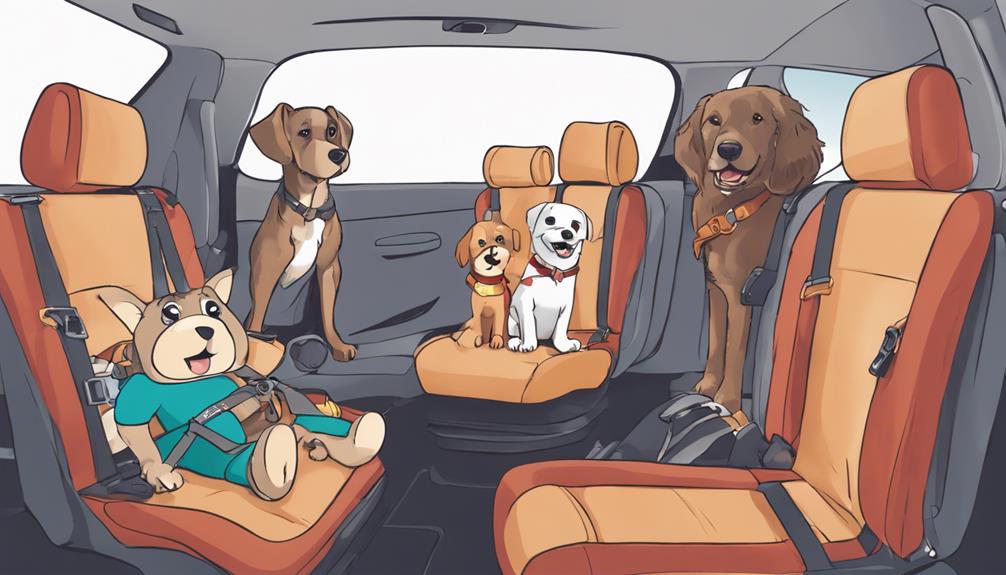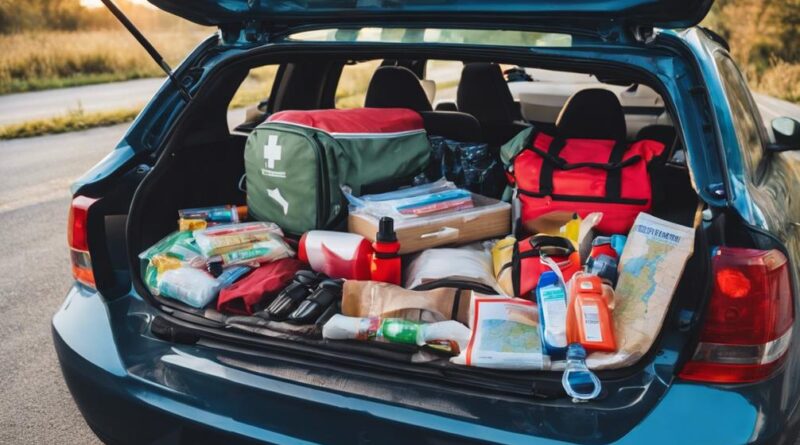Essential Road Trip Safety Checklist for Adventurers
As you gear up for your next adventure on the open road, remember that your vehicle is more than just a mode of transportation; it's your trusted companion through the twists and turns of your journey.
But before you set off, there are crucial steps you need to take to ensure a safe and enjoyable trip. From checking your vehicle's maintenance to packing an emergency kit, and preparing for unexpected weather changes, this checklist will help you navigate the road ahead with confidence and peace of mind.
Vehicle Maintenance
Regularly checking your vehicle's maintenance schedule will ensure a safe and smooth road trip. Start by monitoring your tire pressure. Proper tire pressure is crucial for optimal fuel efficiency, handling, and overall safety. Underinflated tires can lead to decreased traction and overheating, while overinflated tires are prone to blowouts. Use a tire pressure gauge to check the pressure when the tires are cool, and don't forget to inspect the spare tire as well.
Next, it's essential to keep an eye on your fluid levels. Check your engine oil regularly to ensure proper lubrication, preventing engine damage and overheating. Additionally, inspect the coolant level to avoid your engine from overheating during long drives. Brake fluid, power steering fluid, transmission fluid, and windshield washer fluid should also be at the appropriate levels to guarantee all systems function correctly.
Emergency Kit
Ensuring you have a well-equipped emergency kit in your vehicle is crucial for any road trip. Your emergency kit should include essential items such as first aid supplies, tools for minor repairs, and items to keep you safe in case of an emergency.
First aid supplies are a must-have in your emergency kit. Make sure you have bandages, antiseptic wipes, pain relievers, and any necessary medications for you and your fellow travelers. These items can be vital in case of minor injuries or accidents during your journey.
Additionally, include supplies like a flashlight, extra batteries, a multi-tool, and a blanket to help you stay prepared for unforeseen circumstances. These items can assist you in roadside assistance situations or temporary fixes until you can reach a mechanic.
Communication devices such as a fully charged mobile phone, a portable charger, and a road map are essential for staying connected and finding help if needed. Familiarize yourself with emergency procedures before your trip, including who to contact in case of emergencies and basic first aid techniques.
Navigation Tools
Make sure to equip yourself with reliable navigation tools before hitting the road for your trip. Whether you prefer modern technology or the traditional method, having the right tools will ensure you reach your destination smoothly.
GPS devices are a popular choice for many travelers. These handy gadgets provide real-time directions, traffic updates, and points of interest along your route. Make sure your GPS is updated with the latest maps to avoid any surprises on the road.
If you like a more hands-on approach, brushing up on your map reading skills is essential. While GPS devices are convenient, knowing how to read a map can be a lifesaver in areas with poor signal or when technology fails. Familiarize yourself with the symbols, legends, and scales on a map before your journey. Remember to keep physical maps as backup in case of battery issues or signal loss.
Combining both GPS devices and map reading skills can provide you with a comprehensive navigation strategy. GPS devices offer precise directions, while map reading allows you to have a broader understanding of your surroundings. By utilizing these navigation tools effectively, you can navigate confidently and enjoy a stress-free road trip.
Rest Stops
Plan your road trip itinerary to include strategic breaks at rest stops for optimal relaxation and safety. Rest stops are essential for recharging both you and your vehicle.
When making pit stops, remember to pack healthy snacks to keep your energy up and avoid unhealthy fast food options often available at rest areas. Having nutritious snacks like nuts, fruits, or granola bars on hand won't only keep you feeling good but also help you stay alert on the road.
Additionally, if you're traveling with pets, rest stops are a great opportunity to tend to their needs. Make sure to bring along water and a bowl for your furry friend, especially on hot days. Take your pet for a short walk or let them stretch their legs a bit to prevent them from getting restless during the journey. Remember to clean up after your pets at rest stops to be courteous to other travelers.
Driver Rotation
When embarking on long road trips, considering driver rotation can help maintain alertness and prevent fatigue. Implementing driving strategies such as sharing the driving responsibilities among all licensed passengers can ensure that someone is always fresh behind the wheel. This approach not only helps in fatigue management but also allows for a safer and more enjoyable journey.
Before setting off, it's essential to discuss the driver rotation plan with your fellow travelers. Establishing a schedule that factors in everyone's comfort and driving preferences can make the process smoother. Additionally, having roadside assistance and insurance coverage in place provides an extra layer of security in case of any unforeseen circumstances during the trip.
Remember to take breaks at designated rest stops or safe locations to stretch your legs, grab a snack, and refresh before taking over the wheel. Stay alert, hydrated, and well-rested to ensure optimal driving performance. Rotate drivers at regular intervals, ideally every two hours, to combat monotony and prevent drowsiness.
Weather Check
Considering the weather conditions before hitting the road is crucial for ensuring a safe and smooth journey. Being prepared and informed about the weather can significantly impact your road trip experience. Here are some essential road trip safety tips related to weather check:
- Check Road Conditions: Before embarking on your journey, make sure to check the road conditions along your route. Look out for any potential hazards such as construction zones, detours, or weather-related road closures. Stay updated on traffic reports to avoid unexpected delays.
- Travel Tips: Pack essentials like an emergency kit, extra blankets, water, and non-perishable snacks in case you get stranded due to inclement weather. Ensure your vehicle is equipped with good tires and functioning brakes to handle different weather conditions. Plan your route carefully, considering weather forecasts and alternative routes if needed.
- Packing Essentials: Depending on the weather forecast, pack appropriate clothing and gear. If you anticipate rain, bring waterproof jackets and boots. In case of extreme heat, carry sunscreen, hats, and plenty of water. For colder conditions, pack thermal layers, gloves, and hats to stay warm.
- Route Planning: Keep an eye on weather updates throughout your trip to anticipate any changes in conditions. Adjust your driving speed and route if necessary to ensure your safety and comfort. Stay flexible and be prepared to make adjustments based on the weather forecast.
Safety Restraints

Before hitting the road, ensure that you and your passengers are properly secured with safety restraints to minimize the risk of injuries in case of an accident. When traveling with children, it's crucial to use appropriate child car seats. Make sure the car seat is installed correctly according to the manufacturer's instructions and that your child is buckled in securely. Remember, child car seats are designed to offer the best protection for young passengers.
For adult passengers, seat belts are non-negotiable. Insist that everyone in the vehicle wears their seat belt before the journey begins. Seat belts are proven to save lives in the event of a crash, so make it a habit to click it every time you get in the car. Properly adjusted seat belts should fit snugly across the lap and shoulder, not across the stomach or neck. Double-check that seat belts aren't twisted to ensure they can provide maximum protection.
Emergency Contacts
Make sure to program emergency contacts into your phone before embarking on your road trip. Having these contacts readily available can be crucial in case of an emergency.
Here are some essential tips regarding emergency contacts:
- Medical Information: Include any relevant medical information such as allergies, blood type, or existing medical conditions next to your emergency contacts. This information can assist first responders in providing you with the necessary care.
- Backup Plan: In addition to storing emergency contacts in your phone, consider having a physical list of contacts in your vehicle as a backup. This can be helpful in situations where your phone is lost, damaged, or out of battery.
- Communication Devices: Ensure that you have multiple communication devices such as a charged cell phone, a power bank, and even a satellite phone if you're traveling to remote areas. Having these devices can help you reach out to your emergency contacts or local authorities if needed.
- Local Resources: Research local resources at your destinations, such as the nearest hospitals, police stations, or roadside assistance services. Knowing where these resources are located can save valuable time during an emergency.
Frequently Asked Questions
How Can I Ensure My Vehicle Is Prepared for Off-Road Driving During a Road Trip?
To ensure your vehicle is ready for off-road driving on your road trip, start by checking the vehicle maintenance and tire pressure. Make sure everything is in good shape and properly inflated.
Pack emergency supplies and navigation tools in case of any unforeseen situations. Being prepared will help you handle any challenges that may come your way while adventuring off-road.
What Should I Do if I Encounter Wild Animals While on the Road?
If you encounter wild animals on the road, stay calm and avoid sudden movements. Slow down or stop your vehicle to give them space.
Don't approach or feed them. Be aware of your surroundings and watch for signs of aggression.
If needed, honk your horn or use your lights to scare them away. Remember, safety comes first when dealing with unexpected wildlife encounters.
Are There Any Specific Tips for Driving in Extreme Weather Conditions Like Heavy Rain or Snow?
When driving in extreme weather like heavy rain or snow, adapt your driving techniques by slowing down, increasing following distance, and avoiding sudden maneuvers.
Make sure your safety equipment like tire chains, snow tires, and windshield wipers are in good condition.
Familiarize yourself with emergency protocols and have communication devices like a charged phone or two-way radio handy.
Stay alert and prepared for changing conditions to ensure a safe journey through challenging weather.
How Can I Prevent Car Theft or Break-Ins While on a Road Trip?
To prevent car theft or break-ins on a road trip, there are several measures you can take.
Make sure your vehicle has a working car alarm system and activate it whenever you step away. Install window locks to deter break-ins.
Park in well-lit areas or secure parking lots, and avoid leaving valuables visible in your car.
Additionally, always keep your car doors locked at all times.
Taking these precautions will help keep your vehicle and belongings safe during your adventure.
What Should I Do if I Get Lost in a Remote Area With No Cell Phone Signal?
If you get lost in a remote area with no cell signal, remember survival skills are key.
Stay calm and assess your surroundings. Use navigation techniques like following natural landmarks and the sun's direction.
If needed, signal devices like mirrors or flashlights can attract attention. Find or build an emergency shelter for protection.
Keep a positive mindset and conserve energy while waiting for help to arrive.
Stay safe and be prepared for unexpected challenges on your adventure.
Conclusion
So before you hit the road, make sure your vehicle is in top shape. Pack an emergency kit and have your navigation tools ready. Plan for rest stops and take turns driving. Check the weather, always wear safety restraints, and keep emergency contacts handy.
With these essentials in mind, you can enjoy a safe and memorable road trip adventure. Happy travels!
